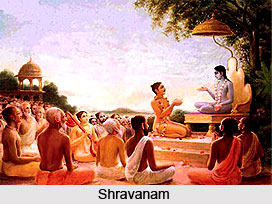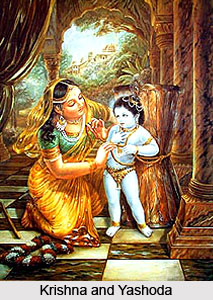 Indian tradition recognizes nine forms of worship in the practice of Bhakti Yoga. These tradition starts from the simple to the more difficult. They are as follows.
Indian tradition recognizes nine forms of worship in the practice of Bhakti Yoga. These tradition starts from the simple to the more difficult. They are as follows.
• Sravanam: Listening to stories of the Lord`s Vila, or play. Bookish knowledge is not sufficient in all cases. The stories must be imparted by inspired teachers and wise men.
• Kirtanam: Singing of God`s glories. Christian hymns also fall into this category as well.
• Smaranam: Remembrance of His name and presence, in mental attitude and unceasing prayer.
• Padasevanam: Service at the Lord`s feet. The world is seen as God`s feet, and in serving humanity one mentally is offering worship to His feet.
• Archanam: Worship of God through such rituals as puja. One offers himself to the Lord, thus breaking the ego.
• Vandanam: Prostration to the Lord with full awareness of His presence in all names and forms. This develops humility.
• Dasyam: Cultivation of the feeling of being a servant of God.
• Sakhyam: Cultivation of feeling friendship toward the Lord, thus establishing a personal relationship.
• Atmanivedanam: Complete surrender of self. This is the equivalent of asampmjnata samadhi, the seedless state in which there is complete acceptance and surrender, and no duality.
Practice of the lower stages, such as listening to stories, is relatively easy. It keeps the mind centered on the Almighty and thus creating positive thought waves and a receptive mind. Even those who are intellectually oriented derive benefit from the stories and chanting if they will open their hearts as well as their minds. When the devotee has been prepared by the earlier stages of worship, he can attempt the more difficult higher stages.
In any case, the bhava, or devotional feeling, of the devotee is of extreme importance. Accommodating the various temperaments of people, there are five different ways of relating to God. The ways can be mentioned as
• Shanta: This pure feeling of peace is devoid of desire, ignorance and emotion. Its presence is not externally apparent. This is the devotional attitude of the Jnana Yogi.
• Dasya: The devotee regards himself as the servant of God, whom he sees in everything but himself. He sees himself as inferior to the rest of humanity. Humbly placing himself in God`s hands, he takes delight in service to all. Hanuman, the monkey chieftain of the Ramayana, who dedicated his life to the service of Ramah, exemplifies this relationship.
• Sashay: God is regarded as a spiritual friend, to whom one can turn for advice, comfort and companionship. One becomes unable to live without His Company. Arjuna`s relationship with Krishna, as set forth in the Bhagabat Gita, is of this nature.
• Ventrally: The relationship is that of parent and child. With God being viewed as a Divine Child. It is exemplified by Yashoda`s relationship with the baby Krishna.
• Methuena: This is the feeling of the lover toward the beloved. It is pure love, unhinged by lust, and is difficult to develop. Encompassing a pure desire to touch and embrace His physical and astral form, this method is encountered frequently in the poetry and writings of the Sufi and Christian mystics. In Yoga it is symbolized by the union of Siva and Shanty in the sharer chitchat at the crown of the head. This is the highest type of devotional feeling.
 There is one more bhava, which remains outside the pale of normal relationships. It is not deliberately cultivated as a path to God, nor is it easy to maintain. This is the feeling of extreme hatred toward God. When one is in constant remembrance of Him, the mind becomes one-pointed and fixed. Through this concentration one is redeemed. It has been seen that evil always falls before goodness. Various demons of Hindu mythology, such as Kamas and Ravana, achieved salvation in this manner.
There is one more bhava, which remains outside the pale of normal relationships. It is not deliberately cultivated as a path to God, nor is it easy to maintain. This is the feeling of extreme hatred toward God. When one is in constant remembrance of Him, the mind becomes one-pointed and fixed. Through this concentration one is redeemed. It has been seen that evil always falls before goodness. Various demons of Hindu mythology, such as Kamas and Ravana, achieved salvation in this manner.
According to classical tradition, the human being experiences fourteen different states of consciousness. These fourteen different types can be mentioned as physical, astral, mental, sacramental, super conscious, unconscious, subconscious, dream, dual, multiple, virat, divine and absolute. The practice of Bhakti Yoga can lead the aspirant through any or all of them. The devotee is particularly subject to visions, lights in the forehead and other manifestations of psychic phenomena. These experiences can be frightening, particularly the loss of physical consciousness. This experience may feel like dying. However, the aspirant must not be faint-hearted, nor should he cling to these experiences, which will appear and reappear for brief periods at the beginning of serious spiritual progress. With persistent and regular practice, one goes beyond these phenomena to meditation, peace and bliss. One must struggle to reach meditation, and struggle even harder to reach Samadhi i.e. the super conscious state.
In all religions Truth becomes diluted by and for the masses. It becomes an external object to be sought after, rather than an inner state of consciousness, which is its true nature. The essential attitude to be taken in any religion is one of taking refuge of confession, prayer, and ultimate surrender to a higher power. It is this inner state of consciousness that Bhakti Yoga nurtures. Without its presence, all other paths of Yoga and any true spiritual progress will not go further.




















